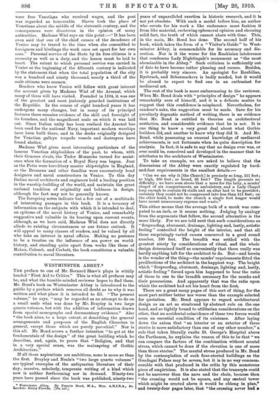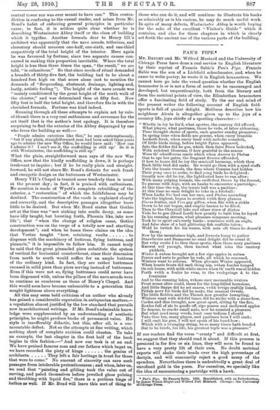WESTMINSTER ABBEY.*
THE preface to one of Mr. Bernard Shaw's plays is wittily headed " First Aid to Critics." This is what all prefaces may be, and what the humble-minded reviewer hopes to find them. Mr. Bond's book on Westminster Abbey is introduced to the public by a preface which removes all doubt as to why it was written and what place it is intended to fill. " The present volume," he says, " may be regarded as an attempt to do on a small scale what was done by Mr. Brayley in two large quarto volumes, but with the addition of information drawn from special monographs and documentary evidence." Also " the book aims, to a large extent, at describing the general arrangements and purposes of the English Churches in general, except those which are purely parochial." Nor is this all. Mr. Bond avows a further intention "to get at the fundamentals of the design" of the great building which he describes, and, again, to prove that " Religion, and that in a very special sense, was the mainspring of Gothic Architecture."
If all these aspirations are ambitions, none is more so than the first. Brayley and Neale's "two large quarto volumes" are typical examples of the antiquarian literature of their day; massive, scholarly, temperate writing of a kind which now is neither forthcoming nor in demand. Ninety-two years have passed since the book was published, ninety-two
• Westminster Abbey. By Francis Bond, A., Hon. A B I B A., ace. London t Henry Frowde. [10e. net.]
years of unparalleled exertion in historic research, and it is not yet obsolete. With such a model before him, an author who covets for his work a like endurance must fashion it from like material, eschewing ephemeral opinion and choosing solid fact, the truth of which cannot abate with time. This, in the main, Mr. Bond has done. The second half of his book, which takes the form of a " Visitor's Guide" to West- minster Abbey, is commendable for its accuracy and dis- cretion. Nor is it the worse for the Ruskinian intolerance that condemns Lady Nightingale's monument as "the most abominable in the Abbey." Such criticism is sufficiently out of date to have become rather pleasing and rococo. Besides, it is probably very sincere. An apologist for Roubiliac, Rysbrach, and Scheemaokers is badly needed, but it would be absurd to expect to find one in an enthusiast for mediaeval art.
The rest of the book is more embarrassing to the reviewer. When Mr. Bond deals with " principles of design " he appears remarkably sure of himself, and it is a delicate matter to suggest that this confidence is misplaced. Nevertheless, for candour's sake, the suggestion must be made. Save for his peculiarly dogmatic method of writing, there is no evidence that Mr. Bond is entitled to theorise on architectural aesthetics, and considerable evidence that he is not. It is one thing to know a very great deal about what Gothic builders did, and another to know why they did it. And Mr.
Bond, while possessing an unusual knowledge of mediaeval achievements, is not fortunate when he quits description for analysis. In fact, it is safe to say that no design ever was, or ever could be, conceived and developed in the manner that he attributes to the architects of Westminster.
To take an example, we are asked to believe that the dimensions of the Abbey were exactly regulated by hard- and-fast requirements in the smallest details :—
" Can we see why it [the Church] is precisely so long, 511 feet; so high, 100 feet ; so broad, 35 feet? The length presents no difficulty ; we have seen above that a nave for the laity, a monks chapel of six compartments, an ambulatory, and a Lady Chapel long enough to contain 64 stalls and an altar had to be provided ; certainly they could not be compressed into less than 511 feet; on the other hand, to make the church a single foot longer would have meant unnecessary expense and waste."
This either means that the average bulk of a monk was com- puted to an inch, or it means nothing. Judging by analogy from the arguments that follow, the second alternative is the more likely. For we are told next that such considerations as " fireproofing, abutment, drainage, lighting and, lastly, artistic feeling " controlled the height of the interior, and that all these surprisingly varied causes concurred in a good round number, 100 feet. The breadth was settled with the greatest nicety by considerations of ritual, and the whole design determined itself so conveniently that there really was hardly anything left for the architect to do. But—and herein is the wonder of the thing—the monks' requirements fitted the predilections of the architect in the happiest way. The height which "fireproofing, abutment, drainage, lighting and, lastly, artistic feeling " forced upon him happened to bear the ratio of three to one to the breadth necessary for the monks and their processions. And apparently that was the ratio upon which the architect had set his heart from the first.
There are a great many pages of this sort of thing, for the most part neither better nor worse than the example selected for quotation. Mr. Bond appears to regard architectural design as an art so straitened by abstract rule on the one hand, and so tightly bound to utilitarian considerations on the other, that an accidental coincidence of these two forces would seem an essential condition of its existence. After laying down the axiom that " an interior or an exterior of three stories is more satisfactory than one of any other number," a rule that taken literally exalts St. George's Hospital above the Parthenon, he explains the reason of this to be that " we can compare the factors of the combination without mental stress, which cannot be done if the elevation is one of more than three stories." The mental stress produced in Mr. Bond by the contemplation of such four-storied buildings as the Guadagni Palace may be severe, but it is in no way commen- surable with that produced in the critic by this monstrous
piece of empiricism. It is also stated that the transepts could not be narrower than the nave and the choir, because then " the crossing would not be square, and any central tower which might be erected above it would be oblong in plan," and twenty-fear pages later, that "the mewing never had II
central tower nor was ever meant to have one." This contra- diction is confusing to the casual reader, and arises from Mr. Bond's habit of enforcing general principles in particular cases ; in fact, it is seldom quite clear whether he is describing Westminster Abbey itself or the class of building which it typifies. Another formula dear to Henry III.'s architect was apparently that the nave arcade, triforium, and clerestory should measure one-half, one-sixth, and one-third respectively of the total height of the interior. Here again he was favoured by fortune, since two separate causes con- curred in making this proportion inevitable. Where the total height is less than three times the span, "the result," we are told, " is calamitous." So that since needs of ritual demanded a breadth of thirty-five feet, the building had to be about a hundred feet high on that score alone (not to mention the demands of "fireproofing, abutment, drainage, lighting and, lastly, artistic feeling "). The height of the nave arcade was "mainly conditioned by the great height of the north walk of the cloister," and was determined thus at fifty feet. Now fifty feet is half the total height, and therefore fits in with the cherished formula. Fortune was kind indeed.
Running through all these attempts to explain art by rule- of-thumb there is a very real enthusiasm and reverence for the art itself that is the author's best apology. It is therefore
surprising to find the exterior of the Abbey disparaged by one who loves the building so well:—
"People admire exteriors like this," he says contemptuously, " but if any plain, straightforward man had been asked three years ago to admire the new War Office, he would have said: 'How can I admire it? I can't see it, the scaffolding is still up.' So it is with Westminster, the scaffolding is still up."
What the plain, straightforward man says of the new War
Office, now that the kindly scaffolding is down, it is perhaps irrelevant to inquire ; but if he be really plain and straight- forward, he will not share Mr. Bond's distaste for such frank and energetic design as the buttresses of Westminster.
Henry VII.'s Chapel is treated more tenderly than is usual at the present day ; in fact, it is praised with enthusiasm.
No mention is made of Wyatt's complete rebuilding of the exterior, a " restoration " of which the faithfulness may be doubted. The construction of the vault is explained clearly and correctly, and the descriptive passages altogether leave little to be desired. But when Mr. Bond states that Gothic art at the time was " not sinking into senile decay, as some have idly taught, but bursting forth, Phoenix like, into new life "; that " when the change of religion came, Gothic construction was on the verge of a, totally new and startling development"; and when he bases these claims on the idea that Vertue taught " how, retaining vaults to dispense with the machinery of buttress, flying buttress, and pinnacle," it is impossible to follow him. It cannot truly be said that the great pinna.cled piers substitute the system of vertical for horizontal counterthrust, since their dimension from north to south would suffice for an ample buttress of the ordinary kind. In fact, they are rather buttresses encased in solid piers than piers serving instead of buttresses. Even if this were not so, flying buttresses could never have been dispensed with, unless the pillars of the nave arcade were to continue as cumbrous as those of Henry's Chapel. And this would soon have become unbearable to a generation that sought lightness above everything.
All this may seem bold criticism of an author who already has gained a considerable reputation in antiquarian matters,— a reputation almost justified by the low standard that prevails now in architectural writings. If Mr. Bond's admirable know- ledge were supplemented by an understanding of aesthetic principles, he might produce books of permanent value. His style is insufferably didactic, but this, after all, is a sur- mountable defect. Not so the attempts at fine writing, which nothing short of complete excision could chasten. To take an example, the last chapter in the first half of the book begins in this fashion:—" And now our task is at an end.
We have praised famous men and our fathers which begat us, we have recorded the piety of kings the genius of architects They left a fair heritage in trust for those that were to come " No amount of sincerity can save such passages from intolerable pretentiousness ; and when, later on, we read that "painting and gilding took the value out of carving, and paled themselves before jewelled glass pulsing and throbbing with liquid fire," there is a perilous tinge of .bathos a well. If Mr. Bond will leave this sort of thing to
those who can do it, and will continue to illustrate his books as admirably as is his custom, he may do much useful work. In spite of many defects, Westminster Abbey is worth buying for the sake of the excellent " Visitor's Guide" which it contains, and also for those chapters in which is clearly set forth the ancient use of the various parts of the building.















































 Previous page
Previous page